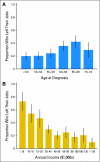Employment among survivors of lung cancer and colorectal cancer
- PMID: 20194860
- PMCID: PMC2849764
- DOI: 10.1200/JCO.2009.24.7411
Employment among survivors of lung cancer and colorectal cancer
Abstract
Purpose: To identify the frequency of and factors associated with changes in employment among cancer survivors.
Methods: This prospective cohort study took place in the context of the population-based Cancer Care Outcomes Research and Surveillance Consortium. Patients with nonmetastatic lung or colorectal cancer who survived approximately 15 months after diagnosis without cancer recurrence provided their self-reported employment status, employment experiences, and changes in insurance coverage at 4 and 15 months after diagnosis. Multiple logistic regression was used to relate sociodemographic and disease factors to the probability of labor force departure.
Results: Among 2,422 eligible patients, employment declined from 3% to 31% over the 15 months after cancer was diagnosed. Labor force departures attributable to cancer occurred in 17% of those employed at baseline. Factors associated with significantly higher rates of labor force departure were lung versus colon cancer, stage III versus I or II disease, lower educational and income levels, and, among colorectal patients, older age. Married women were significantly more likely than unmarried women to leave the workforce. Only 2% of patients lacked health insurance during the study period.
Conclusion: Most employed patients with nonmetastatic lung or colorectal cancer return to work, but approximately one sixth of patients leave the workforce, particularly those with worse prognoses or lower socioeconomic status. Potential economic effects must be considered in management decisions about cancer.
Conflict of interest statement
Authors' disclosures of potential conflicts of interest and author contributions are found at the end of this article.
Figures
Similar articles
-
An economic analysis of female work participation, education, and fertility: theory and empirical evidence for the Federal Republic of Germany.J Labor Econ. 1985 Jan;3(1 Part 2):S218-34. doi: 10.1086/298082. J Labor Econ. 1985. PMID: 12146348
-
Cancer survivors' experiences with insurance, finances, and employment: results from a multisite study.J Cancer Surviv. 2016 Dec;10(6):1104-1111. doi: 10.1007/s11764-016-0554-3. Epub 2016 Jun 9. J Cancer Surviv. 2016. PMID: 27277896
-
Work and income changes after cancer in rural China: A cross-sectional survey.Cancer Med. 2019 Dec;8(18):7859-7868. doi: 10.1002/cam4.2627. Epub 2019 Oct 25. Cancer Med. 2019. PMID: 31650699 Free PMC article.
-
Economic and demographic effects on working women in Latin America.J Popul Econ. 1993;6(4):293-315. doi: 10.1007/BF00599040. J Popul Econ. 1993. PMID: 12286863
-
An analysis of women's labor force participation in France: cross-section estimates and time-series evidence.J Labor Econ. 1985 Jan;3(1 Pt 2):S177-200. doi: 10.1086/298080. J Labor Econ. 1985. PMID: 12267647
Cited by
-
The association of socioeconomic status with quality of life in cancer patients over a 6-month period using individual growth models.Support Care Cancer. 2019 Sep;27(9):3347-3355. doi: 10.1007/s00520-018-4634-y. Epub 2019 Jan 9. Support Care Cancer. 2019. PMID: 30627920
-
Physician preferences and attitudes regarding different models of cancer survivorship care: a comparison of primary care providers and oncologists.J Cancer Surviv. 2013 Sep;7(3):343-54. doi: 10.1007/s11764-013-0281-y. Epub 2013 Mar 24. J Cancer Surviv. 2013. PMID: 23526165
-
Working situation of cancer survivors versus the general population.J Cancer Surviv. 2015 Jun;9(2):349-60. doi: 10.1007/s11764-014-0418-7. Epub 2014 Dec 10. J Cancer Surviv. 2015. PMID: 25492237
-
Trajectories of sickness absence and disability pension before and after colorectal cancer: A Swedish longitudinal population-based matched cohort study.PLoS One. 2021 Jan 7;16(1):e0245246. doi: 10.1371/journal.pone.0245246. eCollection 2021. PLoS One. 2021. PMID: 33411852 Free PMC article.
-
Losses of lifetime employment duration and productivity for patients with different subtypes and stages of lung cancer.Eur J Health Econ. 2024 Jul;25(5):775-785. doi: 10.1007/s10198-023-01624-4. Epub 2023 Aug 7. Eur J Health Econ. 2024. PMID: 37548803 Free PMC article.
References
-
- Ries LAG, Melbert D, Krapcho M, et al. Bethesda, MD: National Cancer Institute; 2008. SEER Cancer Statistics Review, 1975-2005.
-
- Short PF, Vasey JJ, Tunceli K. Employment pathways in a large cohort of adult cancer survivors. Cancer. 2005;103:1292–1301. - PubMed
-
- Yabroff KR, Lawrence WF, Clauser S, et al. Burden of illness in cancer survivors: Findings from a population-based national sample. J Natl Cancer Inst. 2004;96:1322–1330. - PubMed
-
- Messner C, Patterson D. The challenge of cancer in the workplace. Cancer Pract. 2001;9:50–51. - PubMed
-
- Institute of Medicine. Washington, DC: National Academies Press; 2005. From Cancer Patient to Cancer Survivor: Lost in Transition.
Publication types
MeSH terms
Grants and funding
LinkOut - more resources
Full Text Sources
Medical



